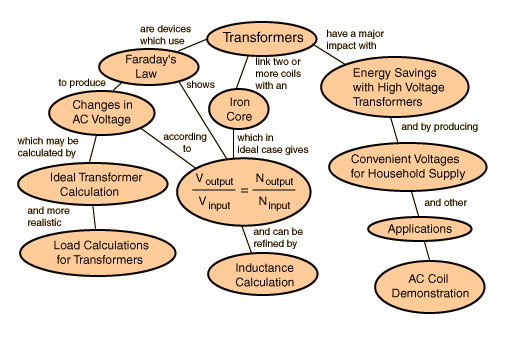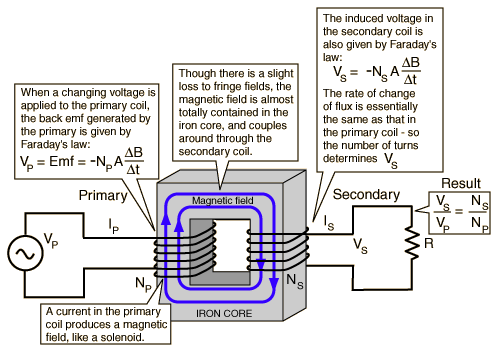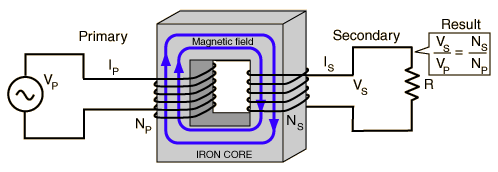Transformers from a physics standpoint
claimed by vrivero3

A transformer makes use of Faraday's law and the ferromagnetic properties of an iron core to efficiently raise or lower AC voltages. It cannot increase power so that if the voltage is raised, the current is proportionally lowered and vice versa.
The Main Idea

From Faraday's law as well as conservation of energy we see that an ideal transformer the voltage ratio is equal to the turns ratio, and power in equals power out. Transformers uses both of these to convert from either high to low or low to high voltages.
A Mathematical Model
For a "step-down" transformer (one that converts from high to low voltage and increases current):
If a solenoid is built wrapping [math]\displaystyle{ {N}_{1} }[/math] turns around a hollow cylinder for the primary coil, and wrapping [math]\displaystyle{ {N}_{2} }[/math] turns around the outside of the secondary coil, and then connecting the primary coil to a an AC power supply, the emf that will develop in the secondary coil will be as follows:
The magnetic field made by the primary coil: [math]\displaystyle{ B = \frac{\mu_0IN_1}{d} }[/math] The cross-sectional area of the solenoid is A, so the emf in one turn of the secondary coil is: [math]\displaystyle{ \frac{AdB}{dt} }[/math] The total emf in the secondary coil is [math]\displaystyle{ {N}_{2} }[/math] times the emf in one turn, so the potential difference across the secondary coil is: [math]\displaystyle{ {N}_{2}A(mu_0{N}_{1}/d)dI/dt }[/math] .
The potential difference across the primary coil is [math]\displaystyle{ \frac{LdI}{dt} }[/math], where [math]\displaystyle{ L = \frac{\mu_0AIN_1^2}{d} }[/math], so the potential difference across the primary coil is: [math]\displaystyle{ A({\mu_0}IN_1^2/d)dI/dt }[/math]
Comparing [math]\displaystyle{ emf_2={N}_{2}A(mu_0{N}_{1}/d)dI/dt }[/math] with [math]\displaystyle{ emf_1= A(mu_0{N}_{1}^2/d)dI/dt }[/math], we see that [math]\displaystyle{ emf_2= ({N}_{2}/{N}_{1})emf_1 }[/math]. The ratio of the number of turns determines the change in voltage.
Faraday's law applied to a transformer can be written as: [math]\displaystyle{ \frac{V_s}{V_p}= \frac{N_s}{N_p} }[/math], where the subscripts refer to primary and secondary coils.
Because energy is conserved and power is [math]\displaystyle{ I \Delta {E} }[/math], the smaller voltage in the secondary coil is accompanied by a larger current. This can be written as: [math]\displaystyle{ P_p= V_pI_p=V_sI_s = P_s }[/math].
In the case of a "step-up" transformer, the primary coil has few turn and the secondary many, therefore increasing the voltage and decreasing the current.
A Computational Model
How do we visualize or predict using this topic. Consider embedding some vpython code here Teach hands-on with GlowScript
Examples
Be sure to show all steps in your solution and include diagrams whenever possible
Simple
A thin coil has 10 rectangular turns of wire. When a current of 4 A runs through the coil, there is a total flux of 6 ✕ 10−3 T · m2 enclosed by one turn of the coil (note that Φ = kI, and you can calculate the proportionality constant k). Determine the inductance in henries. A transformer has a primary coil with 102 turns and a secondary coil of 360 turns. The AC voltage across the primary coil has a maximum of 124 V and the AC current through the primary coil has a maximum of 3 A. What are the maximum values of the voltage and current for the secondary coil?
Φ = kI
6 ✕ 10−3 T · m2 = k(4A)
k= .015H
Middling

A transformer has a primary coil with 102 turns and a secondary coil of 360 turns. The AC voltage across the primary coil has a maximum of 124 V and the AC current through the primary coil has a maximum of 3 A. What are the maximum values of the voltage and current for the secondary coil?
[math]\displaystyle{ {V_s}=? {V_p}= 124V {N_s}= 360 {N_p}= 102 }[/math].
[math]\displaystyle{ \frac{V_s}{V_p}= \frac{N_s}{N_p} }[/math].
[math]\displaystyle{ \frac{V_s}{124V}= \frac{360}{102} }[/math].
[math]\displaystyle{ {V_s}= 438V }[/math].
[math]\displaystyle{ P_p= V_pI_p=V_sI_s = P_s }[/math].
[math]\displaystyle{ V_p=124V I_p=3A V_s= 438V I_s = ? }[/math].
[math]\displaystyle{ (124V)(3A)= (438V)I_s }[/math].
[math]\displaystyle{ I_s = 0.85A }[/math].
Difficult
Connectedness
- How is this topic connected to something that you are interested in?
- How is it connected to your major?
- Is there an interesting industrial application?
History
Put this idea in historical context. Give the reader the Who, What, When, Where, and Why. The property of induction was discovered in the 1830's but it wasn't until 1886 that William Stanley, working for Westinghouse, built the first reliable commercial transformer. It was first designed and used in both experimental and commercial systems by Ottó Bláthy, Miksa Déri, Károly Zipernowsky of the Austro-Hungarian Empire. The first AC power system that used the modern transformer was in Great Barrington, Massachusetts in 1886. In 1891 mastermind Mikhail Dobrovsky designed and demonstrated his 3 phase transformers in the Electro-Technical Exposition at Frankfurt, Germany.
DC power was mainly used in the 1880's but it was hard to transmit over distance because it requires high voltage and a thin wire or low voltage and a wide wire. High voltage on DC is very dangerous, and with low voltage the wire would be so thick that it would be impractical. With AC power, high voltage is also used to move electricity down a long wire. AC is more practical, however, because once the power reaches the destination, a transformer can be used to change the voltage down to a manageable level.
See also
This will give you a general understanding of Faraday's Law, which is the basis behind transformer technology.
Inductance is another property of an electrical conductor derived from Faraday's law.
Changing the flux of a magnetic field around a coil will induce voltage.
This will give you more detail on AC current and how it works along with a transformer.
Transformers from a circuits approach as opposed to a circuits approach
Further reading
Books, Articles or other print media on this topic
External links
http://hyperphysics.phy-astr.gsu.edu/hbase/magnetic/transf.html
https://en.wikipedia.org/wiki/Transformer
http://www.edisontechcenter.org/Transformers.html
References
Chabay, R., & Sherwood, B. (2015). Electric Potential. In Matter & interactions (4th ed., Vol. Two, pp. 920). Danvers, Massachusetts: J. Wiley & sons.
http://hyperphysics.phy-astr.gsu.edu/hbase/magnetic/transf.html